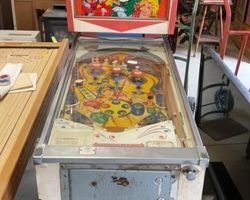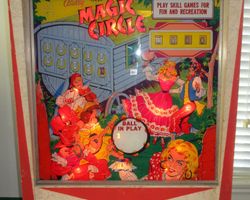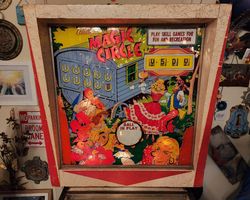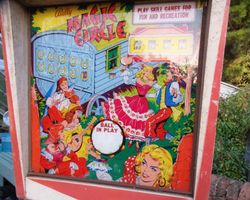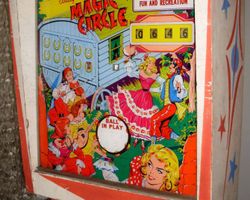Magic Circle
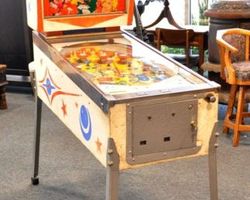
Average Prices: USD $200 to $700
Produced: June, 1965
Production Run: 580 units
Machine Type: Electro-mechanical
Players: 1
Design by: Ted Zale
Pinball machines often embody a distinct era in their design, mechanics, and artistry. Magic Circle, released in June 1965 by Bally Manufacturing Corporation, serves as a compelling example of this truth. With its mystical theme and characteristic Electro-Mechanical (EM) gameplay, Magic Circle offers a glimpse into Bally's design philosophy during the mid-1960s. Produced in limited numbers, this machine holds a particular allure for collectors and enthusiasts who appreciate its unique blend of visual charm and gameplay challenge.
History and Background
Bally Manufacturing Corporation, a prominent force in the amusement industry, released Magic Circle in June 1965. This single-player Electro-Mechanical machine, identified as Model 757, emerged from a period of intense innovation in pinball design. The creative vision behind Magic Circle belonged almost entirely to Ted Zale, who is credited with the machine's design, concept, animation, and mechanical engineering. Zale's comprehensive involvement shaped the machine from its foundational ideas to its intricate playfield elements.
The central theme of Magic Circle revolves around astrology, fortune-telling, and the enchanting world of a gypsy encampment. This mystical motif, common in entertainment of the era, provided a rich canvas for the game's artistic and mechanical elements. Bally produced a total of 580 units of Magic Circle, a relatively low production run that contributes significantly to its current rarity. This limited availability means that encountering a well-preserved Magic Circle today is an uncommon event, adding to its intrigue among pinball history enthusiasts. The machine's release came at a time when pinball was evolving, moving towards more complex objectives while retaining the mechanical charm of its EM predecessors.
Signature Features and Design
Magic Circle distinguishes itself through a cohesive design that merges its mystical theme with specific mechanical features. The artwork is a standout element, particularly the backglass, which depicts "stunning girls" within a gypsy fortune-telling setting, adorned with astrological symbols and vibrant colors. This artwork extends to the playfield, immersing players in the machine's enchanting atmosphere. The display is handled by mechanical reels, a standard for the era, accurately tracking scores up to 9,999 points.
Mechanically, Magic Circle incorporates a classic two-flipper setup for player interaction. The playfield is populated with three pop bumpers and six mushroom bumpers. These mushroom bumpers, characteristic of many Bally EM designs from the period, offer a unique rebound dynamic compared to traditional round bumpers, influencing ball trajectory in distinct ways. Two slingshots strategically placed near the flippers propel the ball back into play with force.
Beyond these fundamental components, Magic Circle features two significant ball control mechanisms: an upper free ball gate and a right outlane free ball gate. These gates offer alternative ball paths and opportunities for extended play or specific scoring. The upper gate, in particular, ties into one of the machine's core objectives, reinforcing the connection between playfield mechanics and gameplay progression. The manual plunger initiates each ball, a direct and tactile interaction that grounds the player in the mechanical nature of the game.
Playfield and Mechanics
The playfield layout of Magic Circle is often described as unique and engaging, designed to encourage players to explore various shot opportunities rather than focusing on a single dominant path. The overall aesthetic of the playfield complements the backglass art, featuring ornate designs and mystical symbols that reinforce the gypsy fortune-telling theme. The lighting is functional, highlighting key targets and pathways, guiding the player through the game's objectives.
Key elements of the playfield include a sequence of targets, specifically a 1-5 sequence that players must complete to advance their score or trigger specific events. These targets are strategically positioned to demand precise shots. One notable shot involves a "long shot to a gate," requiring accuracy and control to successfully navigate the ball across the playfield. This shot, alongside the various bumpers and targets, contributes to the machine's reputation for having a good overall flow, where the ball can move fluidly between different areas of the playfield.
The integration of the upper free ball gate is crucial to the playfield's dynamic. Shooting the ball through this upper gate is not merely a scoring opportunity; it activates a specific feature on the backglass. The right outlane free ball gate offers a reprieve, potentially returning a ball that might otherwise have drained, adding a layer of strategic depth and preventing premature game overs from unfortunate bounces. The combination of these features creates a playfield that is both challenging and rewarding for players who master its intricacies.
Gameplay Dynamics
The gameplay of Magic Circle is rooted in the traditional Electro-Mechanical scoring model, where players aim to accumulate points and earn replays. The machine supports either 3-ball or 5-ball play, adjustable by the operator, allowing for variations in game length and difficulty. The maximum score displayed on the mechanical reels is 9,999 points, a common limit for machines of this era. Replays, awarded for achieving certain scores or fulfilling specific objectives, are tracked on a replay wheel, with a maximum capacity of 25 replays. As with most EM machines, a tilt penalty results in an immediate game over, demanding careful nudging and a steady hand.
The defining gameplay mechanic of Magic Circle centers around a feature directly linked to the machine's theme: the horseshoe. When a player successfully shoots a ball through the upper free ball gate on the playfield, it lights a horseshoe on the backglass. This feature carries over from game to game, meaning accumulated horseshoes are not reset after each play. The primary objective related to this mechanic is to light 10 horseshoes. Upon reaching this milestone, the player is awarded replays, with the quantity (1, 2, or 3) being operator-adjustable. This multi-game objective encourages persistent play and gives a sense of long-term progression beyond a single credit.
Strategic play often involves prioritizing the upper free ball gate to advance the horseshoe count, while simultaneously aiming for the 1-5 sequence targets and capitalizing on the high-scoring pop bumpers. The presence of the right outlane free ball gate offers a lifeline, influencing risk-reward decisions during play. The game is considered challenging to beat, requiring precise shots and an understanding of how the mushroom bumpers redirect the ball. This difficulty stems from the need to hit specific targets consistently and manage ball control to achieve the horseshoe objective, rather than simply relying on random bounces.
Reception and Legacy
Magic Circle has garnered a mixed yet consistently intriguing reception within the pinball community. Its average rating often hovers around a 7 out of 10, indicating a machine that is appreciated for its distinct qualities rather than being universally lauded as a top-tier title. Enthusiasts frequently commend the machine's artwork, particularly the backglass and its attractive gypsy theme, often citing it as exceptional for its period. The playfield layout is also praised for its unique design and good flow, offering an interesting experience distinct from other manufacturers' offerings. Its low production count of 580 units has cemented its status as a relatively rare game, making it a desirable find for collectors seeking uncommon Bally EM machines. The challenge of the game, described as "hard to beat," is also seen as a positive by players who prefer a demanding experience.
However, Magic Circle is not without its criticisms. Some players found the overall gameplay to be somewhat weak, implying that the primary objectives or shot variety might not hold their attention as much as other machines. The characteristic mushroom bumpers, while integral to Bally's EM identity, are a divisive feature; some players appreciate their unique rebound, while others prefer the more predictable action of traditional pop bumpers. Subjective preferences for Bally games from the pre-1975 era sometimes influence opinions, with some players expressing a stronger affinity for games from other manufacturers during that period.
Despite these varied opinions, Magic Circle maintains a specific legacy as an interesting and unique example of Bally's mid-1960s Electro-Mechanical output. Its rarity contributes significantly to its standing, ensuring that it remains a subject of curiosity and pursuit for dedicated enthusiasts. For those who appreciate the distinctive artwork, the challenge of its unique playfield, and the historical context of Bally EM design, Magic Circle offers a rewarding experience, serving as a tangible piece of pinball's rich and evolving history.
Sponsored Links
 Ebay Listings
Ebay Listings
 Auction Results
Auction Results
| Cost | Location | Date |
|---|---|---|
| USD $460 |  Pennsylvania, United States Pennsylvania, United States |
25 June, 2025 |
| USD $405 |  Minnesota, United States Minnesota, United States |
18 November, 2022 |
| USD $999 |  Utah, United States Utah, United States |
05 August, 2022 |
| GBP £630 |  London, United Kingdom London, United Kingdom |
04 July, 2019 |
| AUD $2,450 |  Victoria, Australia Victoria, Australia |
18 January, 2019 |
| GBP £113 |  Sleaford, United Kingdom Sleaford, United Kingdom |
24 November, 2013 |
| GBP £335 |  Southend-on-sea, United Kingdom Southend-on-sea, United Kingdom |
10 July, 2013 |
| GBP £460 |  Penarth, United Kingdom Penarth, United Kingdom |
18 November, 2012 |
| USD $499 |  California, United States California, United States |
29 October, 2011 |
| USD $191 |  Ohio, United States Ohio, United States |
02 July, 2009 |


Private Policy · Search Website · Contact Us
As an eBay Partner, we may earn a commission from qualifying purchases made through links on this site, at no additional cost to you.
All trademarks and copyrighted materials remain property of their respective owners. All other content copyright 2007 - 2025 Pinpedia.

